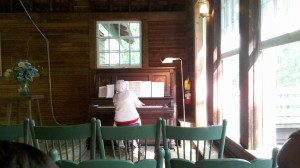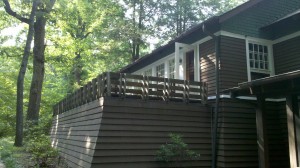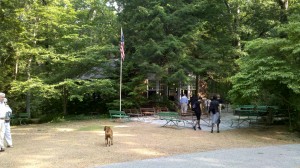Church Experience #22 – June 5, 2011
Little Brown Church (Union Chapel) – Summertown, TN
A Church with a History
I will start this week with an interesting fact that many Chattanoogans may not be aware of: Signal Mountain is not a mountain at all…it is a town that exists on Walden’s Ridge. So when someone says “I live on Signal” or “I’m going up the mountain”, what they really should be saying is “I live in Signal” or “I’m going up the ridge”. Walden’s Ridge extends much further past the town of Signal Mountain with other communities and towns tucked away on winding side streets that most of the time get lumped into the catch-all phrase of “Signal Mountain” that everyone recognizes. One of these communities on Walden’s Ridge is Summertown, which has a very interesting history and a very unique and famous building called Little Brown Church (officially, Union Chapel). For the sake of space, I will not get into the full history of Little Brown Church (there is an entire book on it) other than to say it is over one-hundred years old and was started by Chattanooga families that made Summertown their escape from the summertime heat in the valley and the Yellow Fever that showed up with the mosquitoes. They built this little chapel as a gathering place, but rather than hire a pastor, they decided to save the money and do all the teaching and preaching themselves. Little Brown Church operates from Memorial Day through Labor Day each summer, and to this day is a community-run entity, with no paid staff and a different person serving as the Director each year.

The Director organizes and oversees the efforts of the community to maintain the building and property, schedule the speakers, and facilitate the Sunday church service. Each week there is a guest speaker who is either a member of the local community or a pastor from another church around the Chattanooga area. The Little Brown Church has become such a cherished local phenomenon that even people without a connection to Walden’s Ridge or Signal Mountain know about it. It has become locally famous and for all the right reasons, serving as a shining example of the power of community, and earning such a special place in the lives of all who attended as a child and have continued to return throughout all the seasons of their lives. Little Brown Church was such a special place to one man who I recently met, Jim Frierson, that when he learned that I was writing about local churches for the ChurchSurfer project, he insisted that it be included and followed up by sending me an invitation for the opening day service for 2011. Here is my experience…
Church in the Wildwood

Laura and I parked along the side of the street just down from the Little Brown Church and walked toward the small group of people who were gathering on the stone patio in front of the building. The patio was lined with benches and walled-in by plants and trees that fed into a lush green forest which served as the backdrop for the quaint little chapel building. We were warmly greeted by several people as we explored the outside and inside of the building, taking a few pictures along the way. The structure was exactly what you would expect from something called Little Brown Church in the wildwood…it was all wood from floor to ceiling, with the only signs of modern technology being two black speakers mounted to the rafters, two black microphones on stands at the front, and three black ceiling fans spinning above our heads. The church was open-air with the front doors standing wide and open windows (no screens) running down the length of the side walls. There was a simple wooden podium at the front of the room with a blue and white flower arrangement sitting on a wooden stool beside it and a piano in the front corner, which was occupied by a little white-haired lady who was already playing to welcome everyone in with music. There was a mixture of fold-out chairs and park benches split between the inside of the sanctuary and also on a full length balcony that ran down one whole side of the chapel (which filled up faster than the interior seating). Laura and I went ahead and sat down near the front and watched as more and more people showed up (on transportation that ranged from horses to bicycles to golf carts) to an environment that was much like a family reunion or homecoming, with hugs and handshakes and a crowd that was visibly excited to be returning for another year at their beloved little church. I had expected the people to be a little bit more dressed-down than they actually were, but then I reasoned that Sunday casual to many of these people (who I would assume most of which are fairly wealthy) is still pretty dressed-up for other folks. I held a short conversation with an older couple seated behind us that ended as the service began with this year’s Director, Jim Campbell, announcing the first hymn.
A Splash of Diversity

I looked around the packed-out building as the congregation stood to sing “What a Friend” in its traditional style with piano accompaniment (by the little white-haired lady). After the hymn, a young pre-teen boy led a responsive reading, followed by a prayer from the Director and an introduction to the Johnson brothers, who were the music leaders at Church of the First Born down in Chattanooga, and whose father, Alfred Johnson, was the guest speaker this week. The Johnsons were a black family who had been participating with the Little Brown Church for several years now, bringing what I am sure is a much needed one-week splash of diversity to what might otherwise be an all (or mostly) white church congregation. Although the Little Brown Church lacked in ethnic diversity, it still could be seen as a melting pot of cultural or spiritual diversity, being established by families who worshipped in different denominations during the rest of the year but who had agreed to piece together a worship service that they could all agree on. All of these thoughts floated around in my mind while listening to the Johnson brothers sing stripped-down, raw versions of “How Great Is Our God” and “How Great Thou Art”, making up for the lack of instrumentation with their powerful and soulful vocal abilities. After an offering collection the little white-haired lady returned to the piano to lead the hymn “Savior like a Shepherd Lead Us”. During each hymn, the first two rows of people were directed to turn around and face the rest of the congregation, serving as a make-shift choir. At the end of the song, Pastor Alfred Johnson from Church of the Firstborn, came up to the podium, brought his sons back up to the front and kicked off a high energy, hand-clapping gospel song “On the Battlefield” that provided what might be the only glimpse of a typical black gospel church sing along that many of the people in this congregation may ever experience in person (not meaning to be judgmental here, just based on the observation that people are rarely motivated to venture outside their own bubble).
Labeling a Generation

After some deeply passionate gospel singing, Pastor Johnson engaged the congregation in an equally fiery sermon, reading from Judges 2:10 (stop now and read it) and related that passage to the current generation of youth that are among us. He noted that over the course of history, generations come to be labeled according to an overall mindset that they are known by, such as the one applied to the generation spoken about in Judges 2:10 that followed Joshua and his generation of Israelites. Pastor Johnson pointed out that the current generation of youth in our country is becoming known for their unwillingness to get to know God and their lack of respect for or desire to learn about history and traditions. The current generation of youth are stricken with a plague of violence that stems from the complete absence of appreciation for life, for freedom, and for the well being of a community and its’ people. These issues become manifest with the constant display of anger and outward criticism that consumes many people’s lives today. Pastor Johnson’s voice became increasingly gravelly from the volume at which he delivered his sermon, and his necktie seemed to cinch down tighter and tighter as the temperature rose and the sweat on his forehead beaded up and dripped to the floor. “Why do we have this problem?” he asked rhetorically. Pastor Johnson pointed his index finger at the air as he answered himself…stating that what has become a self-willed society has stopped teaching about God, removed Him from schools, and excluded Him from sermons. People today are trying to promote and get people to know this person or that person, or anyone it seems except Jesus Christ. There is an extreme problem of not living a subdued lifestyle…people get so hyped up all the time that it requires prescription medication to be calm. He argued that when people are so focused on themselves, everyone else around them suffers the consequences. He concluded his sermon with a frenzy of requirements for us to have true reconciliation with God that included the necessity for self-willed people to deny themselves and submit to God, to remain under control, to do away with self-centeredness. “Reconciliation”, he said with a pause, “is not about what is right, but about doing what is right”. Pastor Johnson’s sermon was ferocious, with peaks and valleys and points of emphasis that were expertly crafted and delivered with sincerity and humility. I overheard a lady behind me quip to the lady seated next to her “he sure has enthusiasm, doesn’t he?” I looked at Laura, who had heard the comment as well, and we shared a chuckle as we were both reminded again about the splash of diversity that Pastor Johnson and his sons had brought from the inner-city up the mountain (or ridge) with them.
Lessons to be Learned

After Pastor Johnson returned to his seat, the church Director came back up to announce that the attendance was counted at two-hundred twenty-one people and the collection amount was $1595.00, all of which is donated to local Christian charities since there are no salaries to pay and the church expenses are completely covered by fees from weddings held at the Little Brown Church. As the congregation was dismissed, the children rushed to the front to help ring the church bell…a tradition I’m sure most of the congregation has taken part in at some point during the church’s long history. Laura and I walked back out to the patio, where people lingered in conversation and fellowship. We talked to Jim Frierson and a very sweet lady named Karen Stone, the church historian, about the history of the Little Brown Church and about life in general, and I could have easily seen myself standing in that exact spot during any decade of the last century doing the same thing. It was at that point that I began reflecting on some deep thoughts that I hope you will contemplate as well. If this little church that people love so dearly can be operated by the community, why have our church budgets become so convoluted? Why are churches so focused on maintaining dozens of paid staff members, fancy equipment, huge buildings, and all the creature comforts we can cram inside them? Are those things really a distraction considering that the minimalistic environment of the Little Brown Church seemed to actually emphasize and support the powerful sermon, the sincere worship, and the real sense of community on display? I know what my heart tells me, and I believe that while so many denominations and churches flounder in their misguided attempts to operate according to the example of the New Testament churches, they could learn some valuable lessons from a simple little church in the wildwood on Walden’s Ridge that is what it is because of the love and service of the community that maintains it. It’s just too bad the Little Brown Church isn’t available year round.

Please share the ChurchSurfer blog with anyone who may be interested and make sure to “like” it on Facebook. I truly hope you enjoy reading about the ChurchSurfer journey!
Josh Davis

The Union Chapel – Little Brown Church – is served by a yearly “Superintendent” not a “Director.” The Superintendent is chosen by the board of directors at the end of the season for the next year.
One may call Walden’s Ridge a ridge, and “should be going” up a ridge, HOWEVER!!!
This is a mountain, not a ridge. Missionary Ridge is a ridge. Signal Mountain is a community on Walden’s Ridge, up on the MOUNTAIN that is called Walden’s Ridge.
We mountain folk are might sensitive about hearing our place called either hills or a ridge. It is a mountain, just like Lookout.
Don, I did mistakenly refer to the “Superintendent” of Little Brown Church as “Director”, but chose to leave it after I published the article (and caught the error) because I didn’t think it would affect anyone’s understanding of the position (although there may be some very distinct differences between those two terms that I don’t realize). The mountain vs. ridge debate is one that may rage on forever. The main point I was trying to make was that Walden’s Ridge is incorrectly referred to as Signal Mountain (which is really a town) by most people in the area. I do have a friend that did the research at one point and discovered that according to the most widely accepted definition of “mountain” an elevated land mass must be at least 1,000 meters above the surrounding level. At its highest point, Walden’s Ridge is 929 meters. There are various other mountains around the U.S. that are as low as 250 meters that are also referred to as a mountain, thus the debate will always exist. Sorry to go off on a tangent, just thought it was an interesting comparison that others may want to know more about. And I don’t think anyone will ever correct you or be offended by continuing to call Walden’s Ridge a mountain. Peace & blessings in Christ!
Thanks Fred for the story of the Little Brown. I love attending when visiting Jonj &j Charlotte..